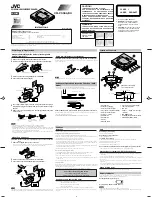
3
HCD-GS10/GS30DAB
Notes on chip component replacement
•
Never reuse a disconnected chip component.
•
Notice that the minus side of a tantalum capacitor may be
damaged by heat.
Flexible Circuit Board Repairing
•
Keep the temperature of the soldering iron around 270
°
C
during repairing.
•
Do not touch the soldering iron on the same conductor of the
circuit board (within 3 times).
•
Be careful not to apply force on the conductor when soldering
or unsoldering.
CAUTION
Use of controls or adjustments or performance of procedures
other than those specified herein may result in hazardous radiation
exposure.
UNLEADED SOLDER
Boards requiring use of unleaded solder are printed with the lead-
free mark (LF) indicating the solder contains no lead.
(Caution: Some printed circuit boards may not come printed with
the lead free mark due to their particular size)
: LEAD FREE MARK
Unleaded solder has the following characteristics.
•
Unleaded solder melts at a temperature about 40
°
C higher
than ordinary solder.
Ordinary soldering irons can be used but the iron tip has to be
applied to the solder joint for a slightly longer time.
Soldering irons using a temperature regulator should be set to
about 350
°
C.
Caution: The printed pattern (copper foil) may peel away if
the heated tip is applied for too long, so be careful!
•
Strong viscosity
Unleaded solder is more viscou-s (sticky, less prone to flow)
than ordinary solder so use caution not to let solder bridges
occur such as on IC pins, etc.
•
Usable with ordinary solder
It is best to use only unleaded solder but unleaded solder may
also be added to ordinary solder.
The laser diode in the optical pick-up block may suffer electrostatic
break-down because of the potential difference generated by the
charged electrostatic load, etc. on clothing and the human body.
During repair, pay attention to electrostatic break-down and also
use the procedure in the printed matter which is included in the
repair parts.
The flexible board is easily damaged and should be handled with
care.
NOTES ON LASER DIODE EMISSION CHECK
The laser beam on this model is concentrated so as to be focused on
the disc reflective surface by the objective lens in the optical pick-
up block. Therefore, when checking the laser diode emission,
observe from more than 30 cm away from the objective lens.
SECTION 1
SERVICING NOTES
This appliance is classified as a CLASS 1 LASER product.
The CLASS 1 LASER PRODUCT MARKING is located on
the rear exterior.
Laser component in this product is capable of emitting radiation
exceeding the limit for Class 1.
When carrying this system
1
Press the
?/1
button to turn the power on.
Insert a disc.
2
Press the CD
u
button to select CD function.
While pressing the
x
button, press the
Z
button for
more 5 seconds.
3
The message “LOCKED” is displayed and the disc slot
is locked. (Even if exiting from this mode, the disc slot
is still locked)
NOTES ON HANDLING THE OPTICAL PICK-UP
BLOCK OR BASE UNIT
CAUTION
Ver. 1.3
MODEL IDENTIFICATION
– Rear Panel –
•
Abbreviation
AR
: Argentine model
CND : Canadian model
E2
: 120 V AC area in E model
E51 : Chilean and Peruvian models
MX : Mexican model
RU
: Russian model
SP
: Singapore model
Model
Part No.
GS10 : E2, E51 models
2-319-562-0
[]
GS10 : MX model
2-319-563-0
[]
GS10 : AR model
2-319-756-0
[]
GS10 : SP model
2-319-760-0
[]
GS10 : AEP model
2-899-469-0
[]
GS10 : RU model
2-899-470-0
[]
GS10 : CND model
2-899-471-0
[]
GS30DAB : UK model
3-099-988-0
[]
Parts No.
Summary of Contents for HCD-GS10
Page 77: ...9 HCD GS10 GS30DAB MEMO ...




































